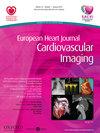冠状动脉CT血管造影:心脏移植患者的新工具:从临床和经济效益到冠状动脉炎症检测
引用次数: 0
摘要
资金来源类型:无。背景:心脏移植患者通常采用侵入性诊断技术监测同种异体心脏血管病变(CAV)。然而,冠状动脉CT血管造影(CCTA)在CAV的早期阶段是一种很有前景的新工具,具有临床和经济效益。目的1)评估与冠状动脉造影(CA)相比,CCTA在放疗和造影剂、费用、住院时间、并发症和诊断准确性方面的非劣效性;2)分析免疫和非免疫危险因素对CCTA患者CAV的不同预测作用;3)通过CCTA冠状动脉脂肪衰减指数(pFAI)研究冠状动脉炎症在CAV进展中的规律。方法回顾性分析179例心脏移植患者:在2021年3月至2022年5月期间,78例进行了CCTA, 101例进行了CA。结果CCTA与CA的放射剂量相近,分别为8.47[1.46-30]和8.15 [1.38-87.34];P = 0.796)和并发症发生率(0 (0%)vs 3 (3%);P = 0,258)。与CA相比,CCTA需要更少的住院时间(0.5小时vs 23.7 12.31小时;P<0.001),成本更低(120欧元对2800欧元;P<0.001)和较少的造影剂(60.4 8.7 ml vs 95.68 47.6ml;p&肝移植;0.001)。CCTA和CA的诊断准确率相似(95% vs 100%;P = 0,169)。在CAV的非免疫危险因素中,只有吸烟对CAV的预测有统计学意义(p = 0.015)。在免疫危险因素中,TNF是CAV进展的唯一独立预测因子(HR 8.23;IC 95% 1.47-45.81;P = 0.019)。CCTA时pFAI作为连续变量或分类变量(>-70.1HU)与CAV进展无统计学相关性(p = NS)。结论CCTA在放疗剂量和并发症发生率方面与CA相似,在住院时间、费用和注射造影剂方面优于CA。CCTA和CA的诊断准确度相当。TNF是CAV进展的唯一独立预测因子。CCTA pFAI评估的冠状动脉周围炎症与CAV的进展无关。本文章由计算机程序翻译,如有差异,请以英文原文为准。
Coronary CT angiography a new promising tool in Heart transplanted patients: from clinical and economical benefits to coronary inflammation detection
Abstract Funding Acknowledgements Type of funding sources: None. Background Heart transplanted patients are usually monitored with invasive diagnostic techniques for detecting cardiac allograft vasculopathy (CAV). However coronary CT angiography (CCTA) is a new promising tool in the initial stages of CAV bringing clinical and economical benefits. Purpose 1) assess the non-inferiority of CCTA in comparison to coronary angiography (CA), in terms of radiation and contrast dose, costs, hospitalization hours, complications and diagnostic accuracy; 2) analyse the different role of immunological and non-immunological risk factors predicting CAV in patients undergoing CCTA; 3) Investigate the rule of coronary inflammation through the pericoronary-fat-attenuation-index (pFAI) at CCTA in the progression of CAV. Methods 179 heart transplanted patients were retrospectively analysed: 78 performed a CCTA and 101 performed a CA between March 2021 and May 2022. Results CCTA and CA showed similar radiation doses (8.47 [1.46–30] versus 8.15 [1.38–87.34]; p = 0.796) and rate of complications (0 (0%) vs 3 (3%); p = 0,258). CCTA in comparison with CA required less hours of hospitalization (0.5 hours versus 23.7 12.31 hours; p<0.001), lower costs (120 euros versus 2800 euros; p<0.001) and less contrast agent (60.4 8.7 ml versus 95.68 47.6ml; p<0.001). Diagnostic accuracy was similar between CCTA and CA (95% vs 100%; p = 0,169). Among the non immunological risk factors for CAV, only smoking showed a statistically significance in predicting CAV (p = 0.015). Among immunological risk factors, TNF was the only independent predictor in the progression of CAV (HR 8.23; IC 95% 1.47–45.81; p = 0.019). There were no statistically correlation between pFAI at CCTA either as a continuous variable or as a categorical variable (>-70.1HU) and the progression of CAV (p = NS). Conclusions CCTA is similar to CA in terms of radiation dose and rate of complications and is superior in terms of hospitalization hours, costs and contrast agent injected. Diagnostic accurancy was equivalent between CCTA and CA. TNF was the only independent predictor in the progression of CAV. Pericoronary inflammation assessed by pFAI at CCTA was not associated with the progression of CAV.
求助全文
通过发布文献求助,成功后即可免费获取论文全文。
去求助

 求助内容:
求助内容: 应助结果提醒方式:
应助结果提醒方式:


